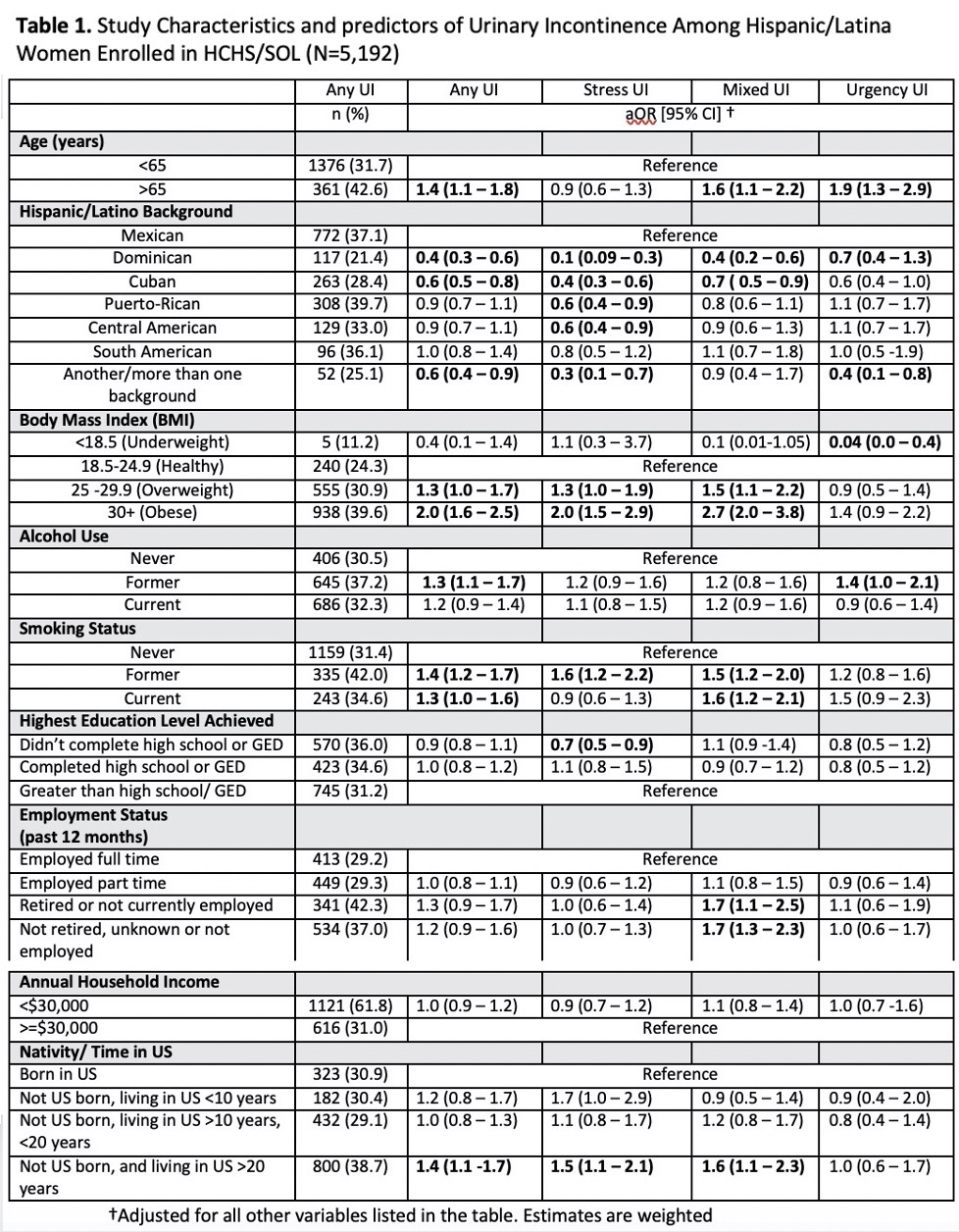Back
Poster, Podium & Video Sessions
Podium
PD06: Urodynamics/Lower Urinary Tract Dysfunction/Female Pelvic Medicine: Female Incontinence: Therapy I
PD06-10: Predictors of Urinary Incontinence among Hispanic/Latina Women in the United States: Findings from The Hispanic Community Health Study/ Study of Latinos (HCHS/SOL)
Friday, May 13, 2022
11:00 AM – 11:10 AM
Location: Room 255
Daniel Gonzalez, Isildinha Reis, Christina Cordero, Marc Gellman, Miami, FL, Krista Perreira, Chapel Hill, NC, Martha Daviglus, Olga Garcia-Bedoya, Chicago, IL, Katherine Amin, Raveen Syan*, Miami, FL

Raveen Syan, MD (she/her/hers)
Assistant Professor of Clinical Urology
University of Miami Miller School of Medicine
Podium Presenter(s)
Introduction: Studies show racial differences in prevalence of stress urinary incontinence (SUI), urge urinary incontinence (UUI), and mixed urinary incontinence (MUI). While medical conditions may vary by Hispanic/Latina backgrounds, differences in urinary incontinence (UI) and UI subtypes are not described. We aim to identify predictors of UI in women of various Hispanic/Latina backgrounds.
Methods: The HCHS/SOL is a multicenter (Bronx, Chicago, Miami, and San Diego), prospective cohort study which includes health-related questionnaires of men and women 18-74 years of age. The Visit 2 Medical Health questionnaire included questions on presence and type of UI. Multiple logistic regression analysis was used to compute odds ratios (OR) and 95% confidence intervals [CI]. We adjusted for age, BMI, smoking and alcohol usage, and socioeconomic factors (education, employment, annual household income, and nativity (time spent living in the 50 US states or DC)). All estimates were weighted and accounted for HCHS/SOL survey design.
Results: Of 5,192 women who self-identified as Mexican, Cuban, Puerto Rican, Dominican, Central American, South American, and more than one background, 1,737 (33%) answered “yes” to UI. In models adjusted for all predictors, trends of increased odds of any UI and UI subtypes were associated with age older than 65 years, increasing BMI, smoking status, and foreign-born Hispanics/Latinas living in the US for more than 20 years. When compared to Mexican women, Dominican (OR=0.4), Cuban (OR=0.6), and mixed heritage (OR=0.6) were less likely to have any UI; all Hispanic/Latina backgrounds except for South American were less likely to have SUI; Dominicans (OR=0.4) and Cubans (OR=0.7) were less likely to have MUI; and Dominicans (OR=0.7) and mixed backgrounds (OR=0.4) were less likely to have UUI. Women of South American heritage did not differ in odds of SUI, UUI, and MUI compared to Mexican background. Socioeconomic factors, such as education, employment, household income, were not associated with any UI (Table 1).
Conclusions: We demonstrate differences in UI, SUI, MUI, and UUI by Hispanic/Latina background, suggesting collective designation of Hispanics/Latinas as a single ethnic group does not adequately describe UI among this diverse group.
Source of Funding: None.

Methods: The HCHS/SOL is a multicenter (Bronx, Chicago, Miami, and San Diego), prospective cohort study which includes health-related questionnaires of men and women 18-74 years of age. The Visit 2 Medical Health questionnaire included questions on presence and type of UI. Multiple logistic regression analysis was used to compute odds ratios (OR) and 95% confidence intervals [CI]. We adjusted for age, BMI, smoking and alcohol usage, and socioeconomic factors (education, employment, annual household income, and nativity (time spent living in the 50 US states or DC)). All estimates were weighted and accounted for HCHS/SOL survey design.
Results: Of 5,192 women who self-identified as Mexican, Cuban, Puerto Rican, Dominican, Central American, South American, and more than one background, 1,737 (33%) answered “yes” to UI. In models adjusted for all predictors, trends of increased odds of any UI and UI subtypes were associated with age older than 65 years, increasing BMI, smoking status, and foreign-born Hispanics/Latinas living in the US for more than 20 years. When compared to Mexican women, Dominican (OR=0.4), Cuban (OR=0.6), and mixed heritage (OR=0.6) were less likely to have any UI; all Hispanic/Latina backgrounds except for South American were less likely to have SUI; Dominicans (OR=0.4) and Cubans (OR=0.7) were less likely to have MUI; and Dominicans (OR=0.7) and mixed backgrounds (OR=0.4) were less likely to have UUI. Women of South American heritage did not differ in odds of SUI, UUI, and MUI compared to Mexican background. Socioeconomic factors, such as education, employment, household income, were not associated with any UI (Table 1).
Conclusions: We demonstrate differences in UI, SUI, MUI, and UUI by Hispanic/Latina background, suggesting collective designation of Hispanics/Latinas as a single ethnic group does not adequately describe UI among this diverse group.
Source of Funding: None.


.jpg)
.jpg)